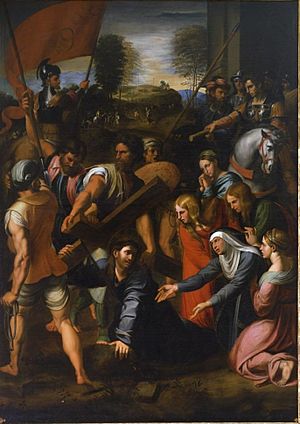Christ Falling on the Way to Calvary facts for kids
Quick facts for kids Christ Falling on the Way to Calvary |
|
|---|---|
 |
|
| Artist | Raphael |
| Year | c. 1514-1516 |
| Type | Oil on panel transferred to canvas |
| Dimensions | 318 cm × 229 cm (125 in × 90 in) |
| Location | Museo del Prado, Madrid |
Christ Falling on the Way to Calvary, also called Lo Spasimo or Il Spasimo di Sicilia, is a famous painting by the Italian artist Raphael. He painted it around 1514–1516. Today, you can see it at the Museo del Prado in Madrid, Spain. This artwork was very important for how Raphael's painting style grew over time.
Contents
What the Painting Shows
This painting shows a well-known moment from the Bible. It captures Jesus carrying his cross on the way to his crucifixion. The scene focuses on the moment Jesus falls. His mother, Mary, is shown feeling intense sorrow and agony. This moment is sometimes called "Lo Spasimo," meaning "the spasm" or "agony."
Key Figures and Details
All the strong feelings in the painting are packed into the front part. The background looks like a stage set. You can see groups of people and crosses far away.
On the left side, a man looks like a figure from another Raphael painting. This painting is called The Judgement of Solomon. In this artwork, Simon of Cyrene helps Jesus by lifting his cross. Simon looks sternly at the guards nearby.
On the right side, you can see the four Marys. Tall guards stand on both sides of the painting. Mary, Jesus's mother, is shown kneeling. She is not completely collapsed or fainted, which is sometimes how this scene is painted.
The Painting's Journey Through Time
This painting was first ordered by a monastery in Palermo, Sicily. Raphael painted it in Rome around 1517. Then, it was sent by ship to Sicily.
A Miraculous Sea Voyage
The ship carrying the painting had a very rough trip. It hit a rock and broke apart. Everything on the ship was lost, except for this painting! It floated in its case all the way to Genoa.
When people found it on the shore, they thought it was amazing. The painting was not damaged at all. It was as if the strong winds and waves respected its beauty.
News of this miracle spread quickly. The monks in Sicily wanted their special painting back. They had to ask the Pope for help to get it. Finally, the painting was safely brought to Sicily. It became very famous in Palermo.
Moving to Spain and Paris
In 1661, the King of Spain, Philip IV, bought the painting. He wanted it for the chapel in his palace, the Royal Alcazar of Madrid.
Later, from 1813 to 1822, the painting was in Paris. This happened because Napoleon took many artworks during his wars. While in Paris, the painting was moved from its original wooden panel onto canvas. This was a common practice in France back then.
After Napoleon's time, many artworks were returned. This painting was one of them. It went back to the Spanish royal collections. Later, it became part of the Museo del Prado collection.
Current Condition and Restoration
Today, the painting is not in perfect condition. This is mainly because it was moved from wood to canvas. However, after being cleaned and restored in 2012, its quality is much clearer.
For a while, some people wondered if Raphael truly painted it himself. But now, most experts agree. They believe Raphael designed and painted a large part of it. His workshop assistants likely helped with the simpler areas.
In 1674, another artist named Juan Carreño de Miranda made a beautiful copy of Raphael's painting. This copy was displayed in a convent in Madrid. Carreño made sure his copy looked very similar to the original. He matched the colors, details, and precise drawing style. This copy is now at The Real Academia de Bellas Artes de San Fernando in Madrid.
Discover More
 In Spanish: El Pasmo de Sicilia para niños
In Spanish: El Pasmo de Sicilia para niños
- List of paintings by Raphael
- Christ Going to Calvary, a painting from 1534 by Polidoro da Caravaggio


